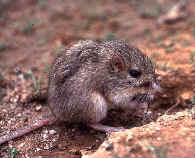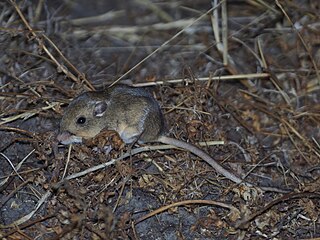
Heteromyidae is a family of rodents consisting of kangaroo rats, kangaroo mice, pocket mice and spiny pocket mice. Most heteromyids live in complex burrows within the deserts and grasslands of western North America, though species within the genus Heteromys are also found in forests and their range extends as far south as northern South America. They feed mostly on seeds and other plant parts, which they carry in their fur-lined cheek pouches to their burrows.

A kangaroo mouse is either one of the two species of jumping mouse native to the deserts of the southwestern United States, predominantly found in the state of Nevada. The name "kangaroo mouse" refers to the species' extraordinary jumping ability, as well as its habit of bipedal locomotion. The two species are:

Perognathinae is a subfamily of rodents consisting of two genera of pocket mice. Most species live in complex burrows within the deserts and grasslands of western North America, They feed mostly on seeds and other plant parts, which they carry in their fur-lined cheek pouches to their burrows.

The desert pocket mouse is a North American species of heteromyid rodent found in the southwestern United States and Mexico. True to its common name, the medium-sized desert pocket mouse prefers sandy, sparsely vegetated desert environments.

The San Diego pocket mouse is a rodent species in the family Heteromyidae. It occupies the northern region of Baja California near San Diego extending into Mexico.

Nelson's pocket mouse is a species of rodent in the family Heteromyidae. It is found in Mexico and in New Mexico and Texas in United States. It is named in honor of the American naturalist Edward William Nelson.

Merriam's kangaroo rat is a species of rodent in the family Heteromyidae. The species name commemorates Clinton Hart Merriam. It is found in the Upper and Lower Sonoran life zones of the southwestern United States, Baja California, and northern Mexico.

Heteromys is a genus of rodents in the family Heteromyidae, commonly known as spiny pocket mice. It is the only extant genus in the subfamily Heteromyinae which also includes the extinct genera Diprionomys and Metaliomys. Heteromys was recently enlarged by inclusion of the members of formerly recognized heteromyine genus Liomys, which was found to be paraphyletic.

The Panamanian spiny pocket mouse, also known as Peter's spiny pocket mouse, is a species of heteromyid rodent endemic to Panama. It is very closely related to Salvin's spiny pocket mouse, and has been placed in the same species group by some authors. It was formerly placed in the genus Liomys, which is now recognized to be paraphyletic and has been subsumed into Heteromys.

The Mexican spiny pocket mouse is a species of rodent in the family Heteromyidae. It is native to Mexico and Texas in the United States where it is found in dry, scrubby habitats. The IUCN has assessed it as being of "least concern". It was formerly placed in the genus Liomys, which is now recognized to be paraphyletic and has been subsumed into Heteromys.

The painted spiny pocket mouse is a species of rodent in the family Heteromyidae. It is found in Mexico and the northern tip of Guatemala. It was formerly placed in the genus Liomys, which is now recognized to be paraphyletic and has been subsumed into Heteromys.
The Jaliscan spiny pocket mouse is a species of heteromyid rodent endemic to Mexico. The specific name spectabilis means "striking", and refers to the animal's relatively bright coloration. It was formerly placed in the genus Liomys, which is now recognized to be paraphyletic and has been subsumed into Heteromys.
The dark kangaroo mouse is a species of rodent in the family Heteromyidae. It is found in California, Idaho, Nevada, Oregon and Utah in the United States.

The pale kangaroo mouse or Soda Spring Valley kangaroo mouse is a species of rodent in the family Heteromyidae. It is endemic to California and Nevada in the United States.

The olive-backed pocket mouse is a species of rodent in the family Heteromyidae. It is found in the central Great Plains of Canada and the United States where it is widespread and relatively common; the IUCN considers it to be of "least concern".

The San Joaquin pocket mouse or Salinas pocket mouse is a species of rodent in the family Heteromyidae. It is endemic to California in the United States where it lives in desert and semi-desert habitats.

The eastern spiny mouse or Arabian spiny mouse is a species of rodent in the family Muridae. They have a wide range, having been found in Middle Eastern deserts, as well as being prevalent in riverine forests in Africa. This is the only species of spiny mouse which may have black coloration. Their diet is similar to other species of spiny mouse, consisting mostly of seeds.

The Chihuahuan pocket mouse is a species of heteromyid rodent found in the southwestern United States and Mexico. It was formerly considered a subspecies of the desert pocket mouse, but was determined to be a distinct species in 1996, following analysis of its mitochondrial DNA.

Heteromyinae is a subfamily of rodents in the family Heteromyidae, commonly known as spiny pocket mice. It contains a single extant genus, Heteromys, as well as the extinct genera Diprionomys and Metaliomys. Heteromys was recently enlarged by inclusion of the members of formerly recognized heteromyine genus Liomys, which was found to be paraphyletic.

The cloud-dwelling spiny pocket mouse is a species of rodent (Rodentia) that is endemic to the high elevations of Cordillera de Tilarán and Cordillera de Guanacaste within Costa Rica. It is contained within the Heteromys desmarestianus species complex.


















